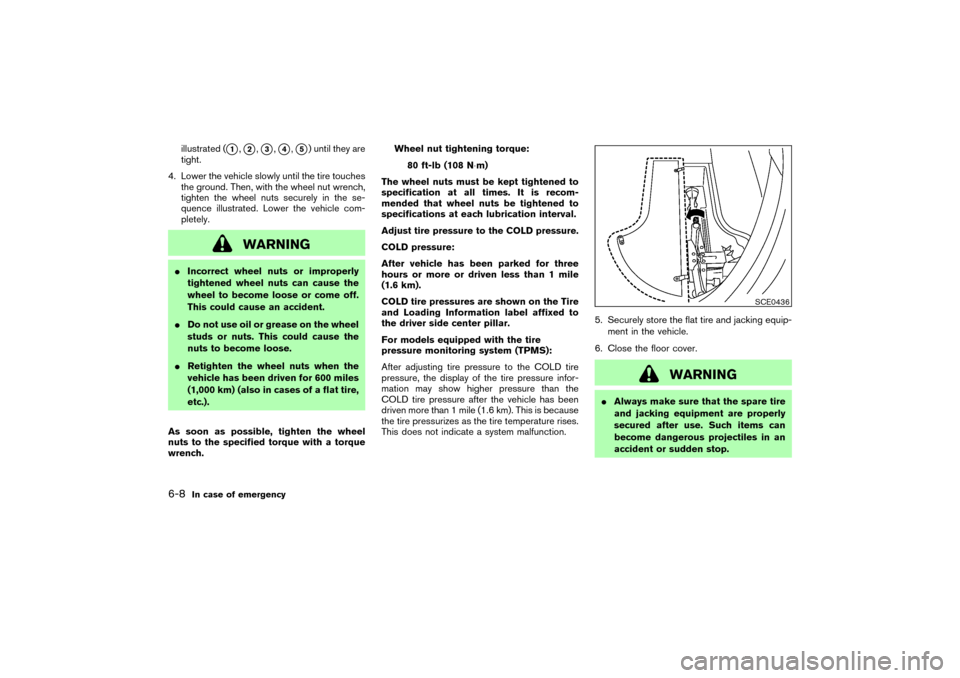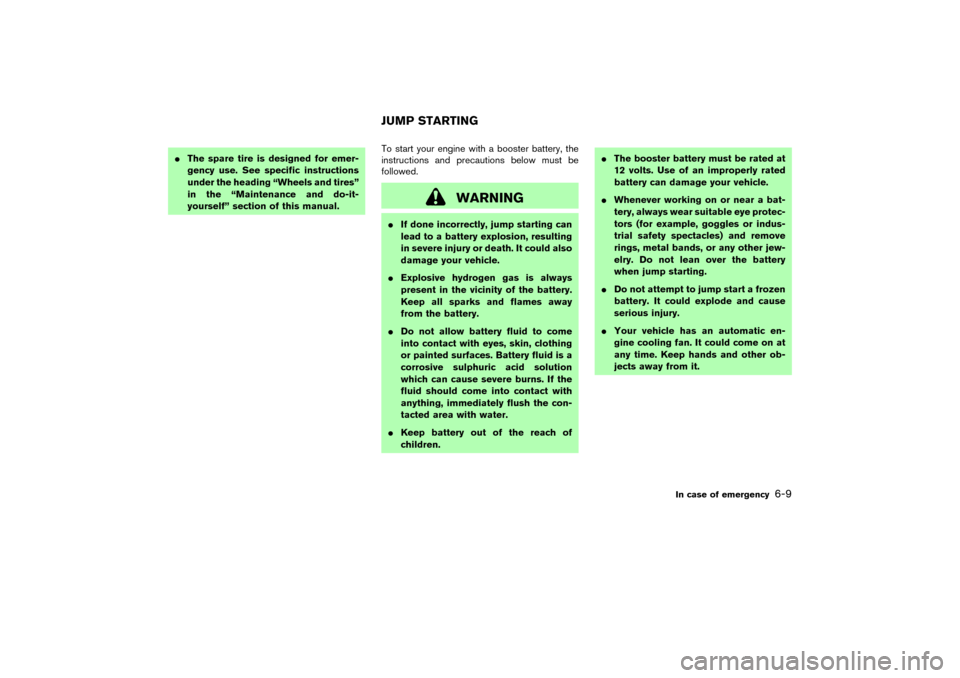Page 248 of 345

Pull up the floor cover
�1
as illustrated and
remove
�2
the jack and tools.
Removing wheel cap (if so equipped)To remove the wheel cap, use the jack rod
�1as
illustrated.
Apply the cloth
�2
between the wheel cap and
jack rod to prevent damaging.CAUTION
Do not use your hands to pry off wheel
caps or wheel covers. Doing so could
result in personal injury.
Jacking up vehicle and removing the
damaged tire
WARNING
�Never get under the vehicle while it is
supported only by the jack. If it is
necessary to work under the vehicle,
support it with safety stands.
�Use only the jack provided with your
vehicle to lift the vehicle. Do not use
the jack provided with your vehicle
on other vehicles.
The jack is designed for lifting only
your vehicle during a tire change.
�Use the correct jack-up points. Never
use any other part of the vehicle for
jack support.
�Never jack up the vehicle more than
necessary.
�Never use blocks on or under the
jack.
�Do not start or run the engine while
vehicle is on the jack as it may cause
SCE0434
SCE0446A
In case of emergency
6-5
�
06.7.5/Z50-D/V5.0
�
Page 250 of 345
The jack should be used on level firm
ground.
2. Loosen each wheel nut one or two turns by
turning counterclockwise with the wheel nut
wrench.Do not remove the wheel nuts
until the tire is off the ground.
3. Carefully raise the vehicle until the tire clears
the ground. To lift the vehicle, securely hold
the jack lever and rod with both hands as
shown above. Remove the wheel nuts, and
then remove the tire.
Installing the spare tireThe spare tire is designed for emergency
use. See specific instructions under the
heading “Wheels and tires” in the “Main-
tenance and do-it-yourself ” section of this
manual.
1. Clean any mud or dirt from the surface
between the wheel and hub.
2. Carefully put the spare tire on and tighten the
wheel nuts finger tight.
3. With the wheel nut wrench, tighten wheel
nuts alternately and evenly in the sequence
SCE0751
SCE0039
In case of emergency
6-7
�
06.7.5/Z50-D/V5.0
�
Page 251 of 345

illustrated (
�1,�2,�3,�4,�5) until they are
tight.
4. Lower the vehicle slowly until the tire touches
the ground. Then, with the wheel nut wrench,
tighten the wheel nuts securely in the se-
quence illustrated. Lower the vehicle com-
pletely.
WARNING
�Incorrect wheel nuts or improperly
tightened wheel nuts can cause the
wheel to become loose or come off.
This could cause an accident.
�Do not use oil or grease on the wheel
studs or nuts. This could cause the
nuts to become loose.
�Retighten the wheel nuts when the
vehicle has been driven for 600 miles
(1,000 km) (also in cases of a flat tire,
etc.).
As soon as possible, tighten the wheel
nuts to the specified torque with a torque
wrench.Wheel nut tightening torque:
80 ft-lb (108 N⋅m)
The wheel nuts must be kept tightened to
specification at all times. It is recom-
mended that wheel nuts be tightened to
specifications at each lubrication interval.
Adjust tire pressure to the COLD pressure.
COLD pressure:
After vehicle has been parked for three
hours or more or driven less than 1 mile
(1.6 km).
COLD tire pressures are shown on the Tire
and Loading Information label affixed to
the driver side center pillar.
For models equipped with the tire
pressure monitoring system (TPMS):
After adjusting tire pressure to the COLD tire
pressure, the display of the tire pressure infor-
mation may show higher pressure than the
COLD tire pressure after the vehicle has been
driven more than 1 mile (1.6 km). This is because
the tire pressurizes as the tire temperature rises.
This does not indicate a system malfunction.5. Securely store the flat tire and jacking equip-
ment in the vehicle.
6. Close the floor cover.
WARNING
�Always make sure that the spare tire
and jacking equipment are properly
secured after use. Such items can
become dangerous projectiles in an
accident or sudden stop.
SCE0436
6-8
In case of emergency
�
06.7.5/Z50-D/V5.0
�
Page 252 of 345

�The spare tire is designed for emer-
gency use. See specific instructions
under the heading “Wheels and tires”
in the “Maintenance and do-it-
yourself” section of this manual.To start your engine with a booster battery, the
instructions and precautions below must be
followed.
WARNING
�If done incorrectly, jump starting can
lead to a battery explosion, resulting
in severe injury or death. It could also
damage your vehicle.
�Explosive hydrogen gas is always
present in the vicinity of the battery.
Keep all sparks and flames away
from the battery.
�Do not allow battery fluid to come
into contact with eyes, skin, clothing
or painted surfaces. Battery fluid is a
corrosive sulphuric acid solution
which can cause severe burns. If the
fluid should come into contact with
anything, immediately flush the con-
tacted area with water.
�Keep battery out of the reach of
children.�The booster battery must be rated at
12 volts. Use of an improperly rated
battery can damage your vehicle.
�Whenever working on or near a bat-
tery, always wear suitable eye protec-
tors (for example, goggles or indus-
trial safety spectacles) and remove
rings, metal bands, or any other jew-
elry. Do not lean over the battery
when jump starting.
�Do not attempt to jump start a frozen
battery. It could explode and cause
serious injury.
�Your vehicle has an automatic en-
gine cooling fan. It could come on at
any time. Keep hands and other ob-
jects away from it.JUMP STARTING
In case of emergency
6-9
�
06.7.5/Z50-D/V5.0
�
Page 256 of 345
must be used.
�Always attach safety chains before
towing.
For information about towing your vehicle behind
a recreational vehicle (RV), refer to “Flat towing”
in the “Technical and consumer information”
section of this manual.
TOWING RECOMMENDED BY
NISSAN
Two wheel drive modelsNISSAN recommends that your vehicle be
towed with the driving (front) wheels off the
ground or place the vehicle on a flat bed truck as
illustrated.
CAUTION
�Never tow CVT models with the front
wheels on the ground or four wheelson the ground (forward or backward),
as this may cause serious and expen-
sive damage to the transmission.
If it is necessary to tow the vehicle
with the rear wheels raised, always
use towing dollies under the front
wheels.
�When towing with the front wheels
on towing dollies:
•Turn the ignition key to the OFF
position, and secure the steering
SCE0438
Two wheel drive models
In case of emergency
6-13
�
06.7.5/Z50-D/V5.0
�
Page 257 of 345
wheel in a straight-ahead position
with a rope or similar device.
Never secure the steering wheel
by turning the ignition key to the
LOCK position. This may damage
the steering lock mechanism.
•Move the selector lever to the N
(Neutral) position.
�When towing two wheel drive CVT
model with the rear wheels on the
ground (if you do not use towing
dollies): Always release the parking
brake.
All-wheel drive modelsNISSAN recommends that towing dollies be
used when towing your vehicle or the vehicle be
placed on a flat bed truck as illustrated.
CAUTION
Never tow CVT AWD models with any of
the wheels on the ground as this may
cause serious and expensive damage to
the drive train.
SCE0439
All-wheel drive models
6-14
In case of emergency
�
06.7.5/Z50-D/V5.0
�
Page 259 of 345
2. Make sure the area in front and behind the
vehicle is clear of obstructions.
3. Turn the steering wheel right and left to clear
an area around the front tires.
4. Slowly rock the vehicle forward and back-
ward.
�Shift back and forth between R (reverse) and
D (drive).
�Apply the accelerator as little as possible to
maintain the rocking motion.
�Release the accelerator pedal before shifting
between R and D.
�Do not spin the tires above 35 MPH (55
km/h).
5. If the vehicle cannot be freed after a few tries,
contact a professional towing service to re-
move the vehicle.6-16
In case of emergency
�
06.7.5/Z50-D/V5.0
�
Page 260 of 345

7 Appearance and careCleaning exterior .................................................................... 7-2
Washing ............................................................................. 7-2
Waxing ................................................................................ 7-2
Removing spots ................................................................ 7-3
Underbody ......................................................................... 7-3
Glass ................................................................................... 7-3
Aluminum alloy wheels.................................................... 7-3
Chrome parts .................................................................... 7-3
Tire dressing .................................................................... 7-3Cleaning interior ..................................................................... 7-4
Floor mats .......................................................................... 7-4
Seat belts ........................................................................... 7-5
Corrosion protection ............................................................. 7-5
Most common factors contributing to vehicle
corrosion............................................................................. 7-5
Environmental factors influence the rate of
corrosion............................................................................. 7-5
To protect your vehicle from corrosion ...................... 7-6
�
06.7.5/Z50-D/V5.0
�